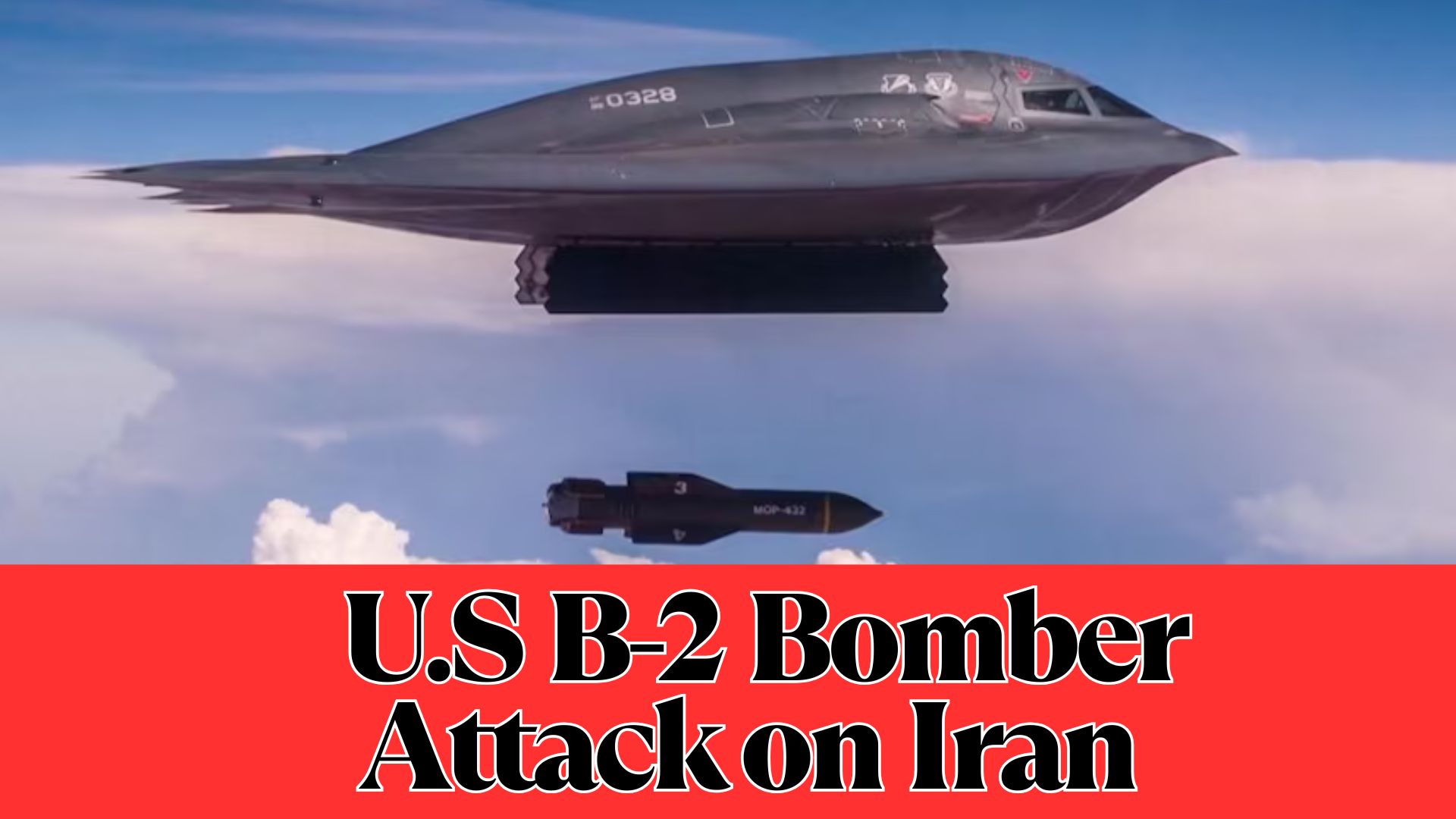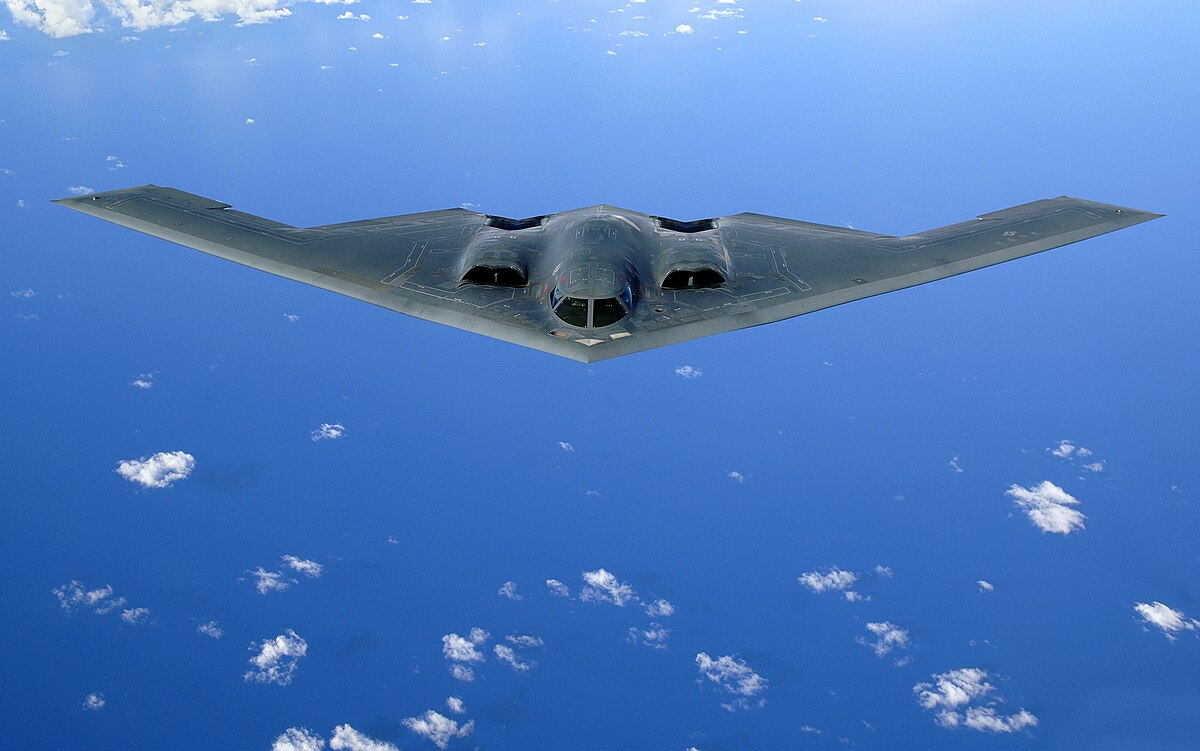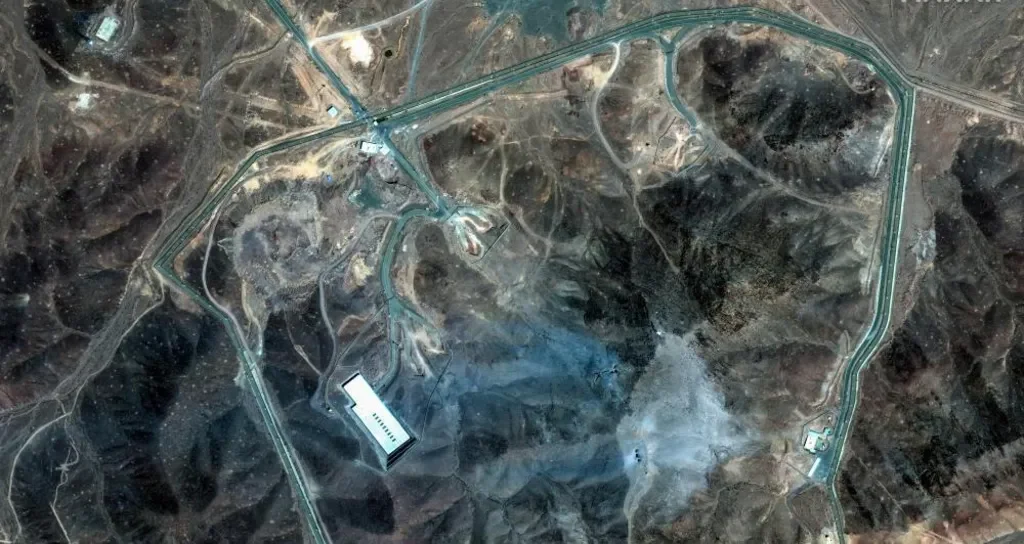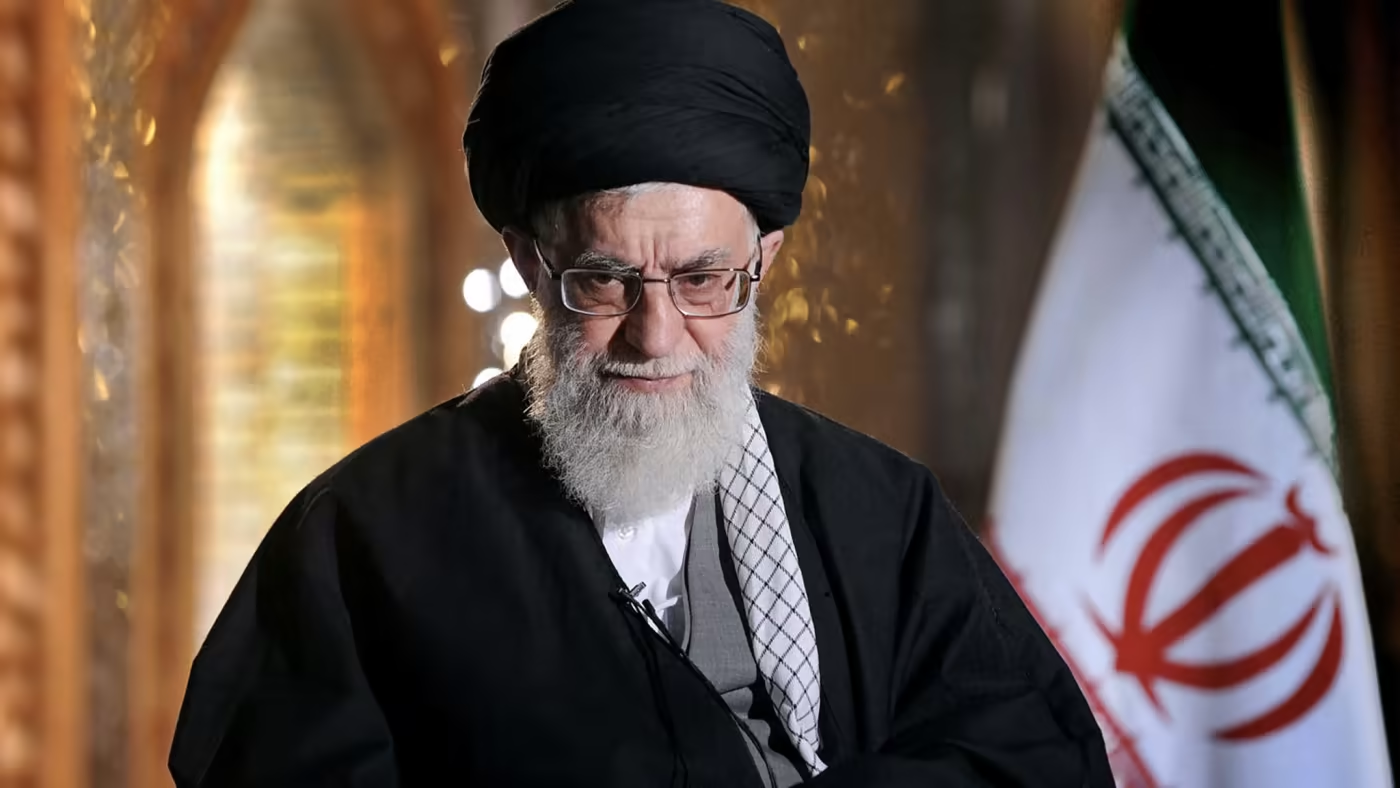U.S. Launches B-2 Bomber Strike on Iran:
In a major escalation, the United States has carried out a confirmed B-2 bomber strike on Iranian military targets. Explore the full details, reasons behind the attack, global reactions, and what it means for the region.

In a stunning development, the United States has officially conducted a B-2 Spirit stealth bomber strike on Iranian military installations. The US has Attacked Iran’s three nuclear sites, Fordow, Natanz, and Esfahan, amid an ongoing conflict between Israel and Iran. This marks a significant escalation in the already volatile Middle East, especially amidst the ongoing Iran-Israel conflict. The Pentagon confirmed the strike in a late-night press briefing, stating that “the operation targeted strategic assets linked to Iran’s missile and drone capabilities.”
This surprise move raises questions about U.S. intentions, the regional balance of power, and the potential for a broader war in the Middle East. Here’s a detailed breakdown of what happened, why it happened, and what comes next.
What Is the B-2 Bomber and Why Is It Important?
The B-2 Spirit is one of the most advanced stealth bombers in the world cost 2.1$ billion US, capable of carrying both nuclear and conventional payloads. Designed to evade radar detection, it allows the U.S. to penetrate deep into enemy territory with minimal warning.

Which Targets Were Hit?
The U.S. strike, led by B-2 Spirit stealth bombers, focused on three major nuclear-related sites in Iran, each critical to Tehran’s controversial atomic infrastructure. The following explains the targets, significance, and the types of munitions used.
-
Fordow Nuclear Site
The Fordow Fuel Enrichment Plant, located deep underground near Qom on of the holiest city for iran, was hit with precision-guided bunker-busting bombs (likely GBU-57 MOPs). These are designed specifically to penetrate reinforced structures. The U.S. aimed to neutralize Iran’s centrifuge assembly units and electrical systems. The B-2’s stealth capability allowed it to bypass radar and deliver the strike before any countermeasures could be launched. Significant structural damage has been reported by independent observers.
- The Fordow’s depth below ground only the US has the kind of “bunker buster” bomb big enough to penetrate the site. It weighs 13,000kg (30,000lb) and is able to drop through about 18m (60ft) of concrete or 61m (200ft) of earth before exploding, according to experts. Due to the depths of Fordow’s tunnels, the MOP is not guaranteed to be successful, but it is the only bomb that could come close.

-
Natanz Nuclear Site
At the Natanz enrichment facility, the B-2 bombers dropped GBU-31 JDAMs (Joint Direct Attack Munitions) targeting above-ground control centers and suspected underground centrifuge halls. This facility has long been seen as central to Iran’s uranium enrichment program. The attack reportedly disabled power grids and computer systems critical to operations. Satellite imagery confirms plumes of smoke and structural collapse in key segments of the compound. some reported says that US use their submarine on attacking Natanz Nuclear Site.
-
Esfahan Nuclear Site
The Esfahan site, known for its uranium conversion and research reactor, was targeted with a combination of conventional GPS-guided bombs and electronic warfare tools. The aim was to disable Iran’s capability to process uranium hexafluoride gas (UF6), essential for enrichment. Military analysts suggest the site’s labs and conversion infrastructure suffered moderate to severe damage. The strike also disrupted radar installations around the facility.
Iranian state media initially denied the extent of the damage, but local reports suggest major explosions occurred in Isfahan and near Shiraz.
Why Did the U.S. Strike Iran Now?
The timing is critical. The strike follows:
-
A wave of Iranian missile and drone attacks on Israel.
-
Iran’s growing involvement in the Red Sea and Strait of Hormuz, threatening global oil supply according to U.S.
-
Mounting pressure from Israel, which has been urging the U.S. to take stronger action against Iran’s support for Hezbollah and Hamas.
According to U.S. officials, this strike is a direct response to intelligence indicating an imminent attack by Iran on American assets in the Gulf region.
Iran’s Response: Threats and Mobilization:
- Iranian officials have condemned the strike, calling it a “blatant act of aggression.” The Iranian Revolutionary Guard Corps (IRGC) has vowed to retaliate “at a time and place of our choosing.”
- Military units across the country have reportedly been placed on high alert, and Iran’s Supreme Leader Ayatollah Ali Khamenei called an emergency meeting of the National Security Council.
- Iranian proxies in Iraq, Syria, and Lebanon—such as Kataib Hezbollah and the Houthis—may also retaliate, raising fears of regional proxy warfare.
- Iran will target the US assets in the middle east like the U.S. Bases in gulf regions and all over middle east. specially in Iraq and in Syria.
- iran will block the strait of Harmuz and it will effect the global economy because the the 20-25% of global oil and gas supply through this root.

U.S. Political Backlash: After Trump’s Iran Strike
The B-2 bomber strike on Iran didn’t just shake the Middle East — it triggered a political firestorm in Washington. Here’s how it unfolded:
Trump Strikes Without Congress:
President Trump ordered a surprise strike on Iran’s nuclear sites without Congressional approval. No formal war declaration, no vote — just a unilateral decision that instantly sparked legal concerns.
Republican Allies Push Back:
Not all Republicans stood by Trump.
- Rep. Warren Davidson (R-Ohio):
“Even if the strike is just, it’s hard to see how it’s Constitutional.”
- Rep. Thomas Massie (R-Ky.):
“This is not Constitutional.”
Massie had just proposed a resolution requiring Congress to authorize any military action against Iran.
Democrats Call It a Violation:
- Sen. Bernie Sanders (I-Vt.) condemned the strike during a rally, shouting:
“Only Congress can take this country to war.”
- Rep. Alexandria Ocasio-Cortez (D-NY) went further:
“This is grounds for impeachment.”
She called it a grave violation of the Constitution and War Powers Act.
Trump Speaks — But Avoids Legal Questions:
In his short speech, Trump defended the strike on national security grounds but offered no legal justification for bypassing Congress. Critics say this sets a dangerous precedent.
A War Powers Showdown Begins:
Now, Congress is debating whether the strike violated the War Powers Resolution. Legal experts and lawmakers are warning of unchecked presidential power and demanding accountability.
Global Reactions: Shock, Warnings, and Calls for Calm:
United Nations:
UN Secretary-General António Guterres called for “maximum restraint by all parties” and warned of a full-scale regional war if diplomacy fails.
Russia:
Moscow condemned the U.S. strike, saying it violates international law and destabilizes the region. Russia also warned that it may increase military cooperation with Tehran.
China:
China, Iran’s key oil trade partner, urged “an immediate ceasefire” and emphasized that “sovereignty must be respected.”
Israel:
Israel welcomed the move, calling it “a necessary step against a growing threat.” Prime Minister Benjamin Netanyahu stated, “The free world must stand united against Iran’s terror empire.”
Conclusion:
The U.S. B-2 bomber strike on Iran marks a dangerous turning point in the Middle East crisis. It has escalated tensions, shaken global diplomacy, triggered potential proxy wars, and even sparked a legal crisis within the U.S. government. Whether this action prevents future conflict—or ignites a much larger war—will depend on the reactions of Iran, its allies, and the global community in the coming days.
CTA:
Stay informed with Muav PK as we continue to uncover the truth behind breaking headlines, military developments, and geopolitical shifts in South Asia.
🔔 Subscribe to our blog for verified, unbiased updates.
📲 Follow us on TwitterX http://muavpk.com, Instagram, and Facebook https://www.facebook.com/share/1AbLcQwDfj/
Comment below with your thoughts — Do you believe the full truth has come out?
FAQs
Q1: Why did the U.S. use B-2 bombers instead of drones?
A: The B-2 can penetrate heavily defended airspace undetected and carry bunker-busting bombs, making it ideal for deep-strike missions.
Q2: Were civilians harmed in the strikes?
A: The Pentagon claims there were no civilian casualties, but independent verification is ongoing.
Q3: Can Iran retaliate militarily?
A: Yes, directly or through proxy groups like Hezbollah and the Houthis. Iranian bases and allies across Iraq, Syria, and Lebanon are likely to be activated.
Q4: Is blocking the Strait of Hormuz possible?
A: Iran has the capacity to threaten this vital route, which could severely disrupt global oil and gas markets.
Q5: Did Trump break the law?
A: Many lawmakers argue he violated the War Powers Act, and there are increasing calls for Congressional investigation or even impeachment.
